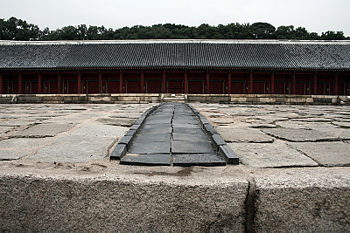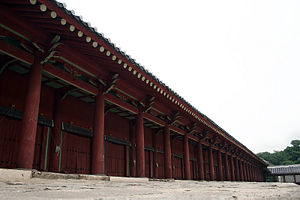Jongmyo
| Jongmyo | ||||||||
|---|---|---|---|---|---|---|---|---|
 | ||||||||
| Korean name | ||||||||
|
Jongmyo is a Confucian shrine dedicated to the memorial services in honor of the Joseon dynasty kings and queens. According to UNESCO, the shrine is the oldest royal Confucian shrine preserved and the ritual ceremonies continue a tradition established since the fourteenth century. Such shrines existed during the Three Kingdoms of Korea period but only the shrines for the rulers of Joseon remain. The Jongmyo Shrine was added to the UNESCO World Heritage list in 1995.
Jongmyo's unique dedication to ceremonies honoring departed Korean kings and queens, the excellent state of preservation of the shire complex also earned Jongmyo the distinction of National Treasure. The heart of Confucianism is to honor those in the subject position, especially kings or presidents since the best have lived selflessly for the nation or kingdom. Living for the sake of the nation is considered one of the greatest virtues in Confucianism.
| Jongmyo Shrine* | |
|---|---|
| UNESCO World Heritage Site | |

| |
| State Party | |
| Type | Cultural |
| Criteria | iv |
| Reference | 738 |
| Region** | Asia-Pacific |
| Inscription history | |
| Inscription | 1995Â (19th Session) |
| * Name as inscribed on World Heritage List. ** Region as classified by UNESCO. | |
History
When built in 1394 by order of King Taejo, it was thought to be one of the longest buildings in Asia, if not the longest. The main hall, known as Jeongjeon, had seven rooms. Each room was reserved for a king and his queen. King Sejong expanded the complex, ordering the construction of Yeongnyeongjeon (Hall of Eternal Comfort). This practice of expansion continued, with the growth of the complex moving from west to east, because of the need to house more memorial tablets during the reigns of later kings until there were a total of nineteen rooms.
During the Seven-Year War, Japanese forces burned down the original shrine and a new complex was constructed in 1601 C.E. which has survived to this day. The original tablets were saved in the invasion by hiding them in the house of a commoner and also survive to this day. There are nineteen memorial tablets of kings and thirty of their queens, placed in nineteen chambers. Each room is very simple and plain in design. Only two kings' memorial tablets are not enshrined here.
Jeongjeon: National treasure of Korea No. 227
The current Jeongjeon is National treasure of Korea No. 227 and is the longest building in Korea of traditional design.
Spirits enter and exit the south entrance gate, the king entered through the east gate, and the performers of the royal ritual entered through the west gate.
Viewed from the king's throne at Gyeongbokgung Palace, Jongmyo Shrine would have been on the king's left while the Sajik Shrine, another important Confucian shrine, sat on the right. This arrangement derived from Chinese practice. The main halls are surrounded by hills. In front of the main hall is the Woldae Courtyard, which extends 150 meters in length and 100 meters in width.
Jongmyo jeryeak: Cultural Property No. 56
Each year an elaborate performance of ancient court music (with accompanying dance) known as Jongmyo jeryeak is performed. Musicians, dancers, and scholars would perform Confucian rituals, such as the Jongmyo Daeje (Royal Shrine Ritual) in the courtyard five times a year. Today the rituals have been reconstructed and revived. The Jongmyo Daeje has been designated as Cultural Property No. 56 and is performed every year in May.
Royal Court Orchestra: Intangible Cultural Property No. 1
The Jongmyo Jerye-ak, the traditional court music of Joseon, is performed by the Royal Court Orchestra and has been designated as Intangible Cultural Property No. 1. This court music has its origins in Chinese court music that was brought to Korea during the Goryeo period. King Sejong composed new music for the ritual based largely on hyangak (with some dangak) in 1447 and 1462.
Gallery
ReferencesISBN links support NWE through referral fees
- Adams, Edward Ben. 1970. Through gates of Seoul; trails and tales of Yi dynasty. Seoul: Sahm-bo Pub. Corp. OCLC: 109132
- Clark, Allen D., and Donald N. Clark. 1969. Seoul; past and present; a guide to Yi Tʼaejoʼs capital. Seoul: Hollym Corp. OCLC: 567884
- Clark, Donald N., and James Huntley Grayson. 1986. Discovering Seoul. Seoul, Korea: Seoul Computer Press. OCLC: 31436379
- Haeoe HongbowÅn (Korea). 2003. Guide to Korean cultural heritage. Elizabeth, NJ: Hollym. ISBN 9781565912137
- Lee, Gil-sang. 2006. Exploring Korean history through world heritage. Seongnam-si: Academy of Korean Studies.
- Suh, Jai-sik. 2001. World heritage in Korea. Elizabeth, NJ: Hollym. ISBN 9781565911710
External links
All links retrieved February 6, 2025.
- UNESCO Jongmyo shrine
- Jongmyo Shrine Life in Korea
Credits
New World Encyclopedia writers and editors rewrote and completed the Wikipedia article in accordance with New World Encyclopedia standards. This article abides by terms of the Creative Commons CC-by-sa 3.0 License (CC-by-sa), which may be used and disseminated with proper attribution. Credit is due under the terms of this license that can reference both the New World Encyclopedia contributors and the selfless volunteer contributors of the Wikimedia Foundation. To cite this article click here for a list of acceptable citing formats.The history of earlier contributions by wikipedians is accessible to researchers here:
The history of this article since it was imported to New World Encyclopedia:
Note: Some restrictions may apply to use of individual images which are separately licensed.




